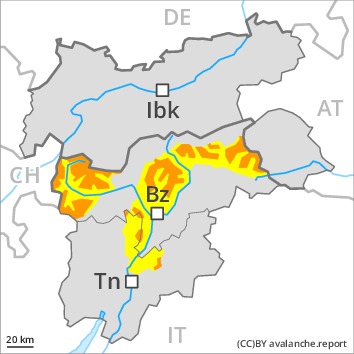
Danger level
 | treeline
|
Avalanche Problem
 | | Wind-drifted snow |
|  | |  |
 | | Gliding snow |
|  | |  |
 | | Persistent weak layer |
|  | |  |

As a consequence of the new snow the avalanche prone locations will become more prevalent from the second half of the night.
High altitudes and the high Alpine regions: On wind-loaded slopes dry slab avalanches are possible, even large ones in isolated cases. The number and size of avalanche prone locations will increase with altitude.
The fresh snow and in particular the sometimes deep wind slabs can be released easily, or, in isolated cases naturally in all aspects. Avalanches can also penetrate deep layers and reach dangerously large size. Weak layers in the upper part of the snowpack can still be released in some places by individual winter sport participants in particular in areas where the snow cover is rather shallow. Low and intermediate altitudes: A latent danger of gliding avalanches exists. Areas with glide cracks are to be avoided as far as possible.
Extensive experience in the assessment of avalanche danger is required.
Snowpack
dp.6: cold, loose snow and wind
dp.2: gliding snow
10 to 30 cm of snow, and even more in some localities, will fall until Thursday above approximately 1000 m. The fresh wind slabs are lying on soft layers in all aspects above the tree line. As a consequence of snowfall the occasionally strong southerly wind, the snow drift accumulations will increase in size.
The snowpack is moist, in particular at low and intermediate altitudes.
Avalanche prone weak layers exist in the centre of the snowpack in all aspects, in particular above approximately 2000 m.
Tendency
Fresh wind slabs require caution. In addition a latent danger of gliding avalanches exists. As a consequence of falling temperatures the snowpack will consolidate during the next few days, in particular below approximately 2000 m in all regions.

Danger level
 | 1800m
|
Avalanche Problem
 | | Wind-drifted snow |
|  | |  |
 | | Gliding snow |
|  | |  |
 | | Persistent weak layer |
|  | |  |

Backcountry touring calls for experience in the assessment of avalanche danger.
High altitudes and the high Alpine regions: On wind-loaded slopes dry slab avalanches are possible, even large ones in isolated cases. The number and size of avalanche prone locations will increase with altitude.
The fresh snow and in particular the sometimes deep wind slabs can be released easily, or, in isolated cases naturally in all aspects. Avalanches can also penetrate deep layers and reach dangerously large size. Weak layers in the upper part of the snowpack can still be released in some places by individual winter sport participants in particular in areas where the snow cover is rather shallow. Low and intermediate altitudes: A latent danger of gliding avalanches exists. Areas with glide cracks are to be avoided as far as possible.
Snowpack
dp.6: cold, loose snow and wind
dp.2: gliding snow
10 to 20 cm of snow will fall until Thursday above approximately 1000 m. The fresh wind slabs are lying on soft layers in all aspects above the tree line. As a consequence of snowfall the occasionally strong southerly wind, the snow drift accumulations will increase in size.
The snowpack is moist, in particular at low and intermediate altitudes.
Avalanche prone weak layers exist in the centre of the snowpack in all aspects, in particular above approximately 2000 m.
Tendency
Fresh wind slabs require caution. In addition a latent danger of gliding avalanches exists.













